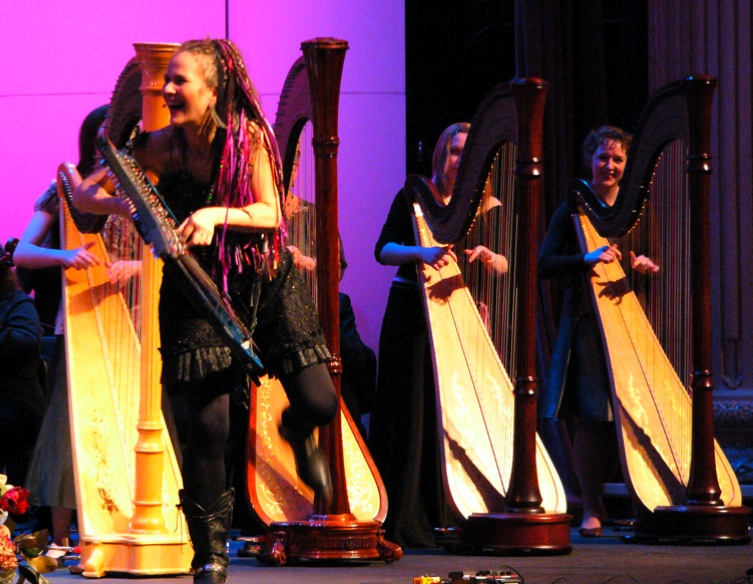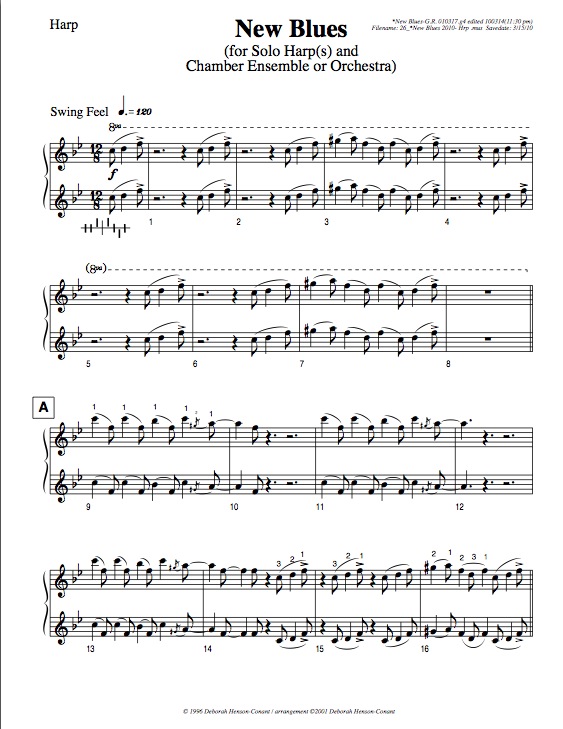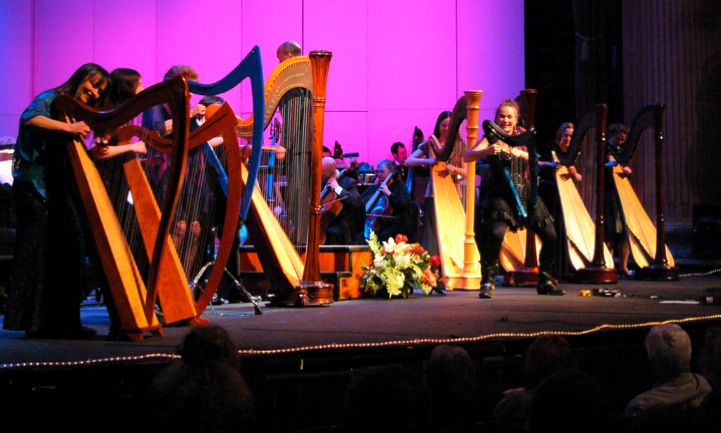
Often,
when I play with symphonies, I suggest that we perform
a special multi-harp version of “New Blues” with
the orchestra. When I do solo shows, sometimes I invite
a local harpist - or several - onstage to play the
same piece with me. This is an info sheet about those
performances.
If
you're reading this - it probably means we'll be playing
together. I look forward to that and to meeting you! |
 ABOUT
THE EXPERIENCE ABOUT
THE EXPERIENCE
Last Updates by DHC on (7/21/11... 3/16/10)
The
name of the piece is "New Blues," and
it's a simplified version created specifically for these
performances. You can download the music below.
When
we play it with a group, we call the group "The Harp-Breakers" or,
using the name of the town, sponsor, state or region we're
in we call the group "The LocalName Harp-Breakers."
Below are
notes about these performances, plus sheet music and MP3
playalong files you can download to help you prepare.
This
version of "New Blues" can be played
by a variety of skill levels (i.e. it's
easily simplifiable). In the past we've gone for
the Wow-Factor
by involving as many harpists as were logistically
possible and the Cute-Factor by involving young
student harpists as well as professionals -- and
we always try to go for the "Solid Music" and "Fun"
factors.
TEACHERS
often work with their students on the piece, and
then they can be involved as a group with the concert
(meaning, the teachers and their students will
often play near each other on the stage).
 ABOUT
THE MUSIC ABOUT
THE MUSIC
(note:
Don't try to print the music at the left. The
music to download is at the bottom of this page) Lever
or Pedal Harp: It can be played on both. It can
be played on any harp of any size. Printing
out the music: If possible, print the music “double
sided” starting with the cover page, to print page
turns correctly. If you print single-sided, there’s
no need to print the cover page.
Errata: Do
not play in m. 75, 76, 77 & 78. Those measures are tacet. Key
/ Levers / Pedals: Even though the piece is in
Bb, make sure you raise your G(s) to G#. So: Bb
Eb G# are your only accidentals and once you set
your harp up, there should be NO lever or pedal changes
through the whole piece.
Tempo
/ Meter: The meter is 12/8 so the metronome beats
4 to every bar -- and every beat is subdivided into 3 (kind
of like 4 triplets in each bar)
Doubling
/ Simplifying: Most of the melody is doubled in
octaves. If you’re more of a beginner and need to
play only one line, that’s fine. Don’t
worry about playing absolutely everything. What’s
important is to play “with” the ensemble, so
even if you play just the first note of the faster runs,
it’s fine -- more advanced players will play the
rest, and your one note will add important emphasis.
12-Bar
Blues Form: The normal 12-Bar Blues starts at
Letter C. Before then, the piece is a kind of modified
Blues form. At letter D, you "lay out" (are tacet)
for 12 bars (or maybe 24, or 36) -- just like you would
in the Blues if players were taking “solos.”
Count-in: On
the playback-mp3 there are two measures of of count-in and
you come in on an upbeat, so you’ll hear the following
beats (but not these words): One-Two-Three-Four |
One-Two-Three And Your In! In
performance we may have a musical introduction, but I'll
also count it
in loud and clear.
The
trick in learning it is to learn what you can play well – even
if it’s not every single note, memorize that, and
play it strong and in time with the music. Have fun, and
get comfortable so you can move around to the rhythm of
the music, and so you'll be able to connect with Deborah.
That’s
the goal of this ensemble!
ABOUT THE PERFORMANCE

You
must memorize the music: This
music is quite easy and there is lots of repetition. There
are MP3 playalong files, so you'll have plenty of opportunity
to get comfortable with the music. It's essential that
you memorize it so that you can respond to me, to each
other and to the ensemble on stage.
No
stands - no stools! We will play the piece without
stands and without stools! That means you'll be standing
when you play. If you harp is very small, then you should
plan to either wear it with a strap, or kneel on the floor.
Harp
Helper: You
must have a designated harp helper with you at all times.
Sometimes these are called "Harp
Dads" or "Harp Hunks" - they can be any
age or gender so long as they're calm, strong and able
to help you get your harp where it needs to go.
Costuming: You
can wear whatever you want, so long as it doesn't conflict
with the symphony or ensemble rules. It's most fun if everyone
dresses up as they would if they were a symphony soloist
(which is what you are!).
Programming: The
piece is usually programmed right after intermission.
ABOUT REHEARSALS Designated
Harp Diva: Because
I will rarely be able to rehearse with you in advance,
each ensemble needs at least one "Designated Harp
Diva" who will rehearse the ensemble. This can be
someone of any gender or age, but it should be someone
used to leading and conducting
ensembles. REHEARSALS:
Harps-Alone
Rehearsals: Rehearsal time with me is limited.
Sometimes I'm is not able to rehearse with you at all,
and sometimes I'll will try to arrange online rehearsals.
That may mean you will need to learn how to use an online
resource like Skype or Livestream. If I'm able to rehearse
with you in person, it's likely it will be shortly before
the orchestra rehearsal,
in a large practice studio - and we probably won't have
a lot of time, so you need to be prepared and ready to
play.
Orchestral
or Ensemble Rehearsals: The
piece is usually rehearsed right after the first orchestra
break. The time with orchestra is VERY, VERY limited.
You will need to be ready to play, and it's likely we
may
get
to go
through the piece only once. You'll probably have to
either leave the harps on stage at that point, and remove
them after the rehearsal, or you may have to remove them
quickly from the stage. That will be determined by the
orchestra management.

ABOUT
PUBLICITY
Like
any symphony soloist you'll
need to contact your local paper to let them know you'll
be performing. You'll also need to let all your friends
know, and post it on social media. You should start doing
this at least 6-weeks before the performance. The best
thing to do is to write a press release, and email it to
your
local
music reviewers and editors of your local paper with a
publicity photo of you.
Here's
an example of a press release you could send to your
paper:
FOR
IMMEDIATE RELEASE. Run through (INSERT DATE OF CONCERT)
CONTACT (INSERT YOUR NAME, EMAIL & PHONE)
(INSERT
NAME OF TOWN) Resident to perform with GRAMMY® Nominee,
(INSERT NAME OF SYMPHONY) (INSERT
TOWN)'s own (INSERT PLAYER) has been specially invited
to perform harp
with GRAMMY®-nominated composer and recording artist Deborah Henson-Conant
and the (INSERT SYMPHONY NAME) on (INSERT DAY & DATE), at (INSERT TIME)
at the (INSERT THEATER-NAME) in (INSERT CITY).
(INSERT
PLAYER) joins Henson-Conant and (INSERT QUANTITY OF
PLAYERS) other local harpists in a unique ensemble
called “The
Harp-Breakers,” during
Henson-Conant’s alternate-symphonic program with the (SYMPHONY NAME)
featuring electric harp, voice and orchestra in a fusion of Folk-Flamenco-Latin-and-Blues.
Visiting
soloist Henson-Conant is a groundbreaking musician
and innovator known for widely diversifying the approach
to the harp - “She’s
doing for the harp what Chuck Berry and Elvis did for the guitar” says
the Denver Post - and inspiring the world’s first commercially-produced
carbon-fibre electric harp, named after her, the “DHC Blue Light.” She
tours internationally in solo and orchestral concerts, and is known for
her music special on PBS, “Invention & Alchemy.”
(SOMETHING
ABOUT THE LOCAL HARP COMMUNITY, LIKE THIS: Henson-Conant
has long known about the rich harp community in the
Puget
Sound
area,
developed by local teachers like Pat Wooster in Tacoma and
Susi Hussong
in Seattle, so when she was invited to perform with the Tacoma Symphony
Orchestra, she immediately inquired about featuring local harpists
in one number: her
symphonic bebop “New Blues.”) “This opportunity is
great for everyone,” says
Henson-Conant, “For the harpists, it’s an opportunity to
rehearse and perform as symphony soloists — and for the audience,
a one-of-a-kind musical experience: bebop with a symphony and 9 harps!”
(NAME
OF PLAYER) will be featured in this unique ensemble. (INSERT A FEW
BIO NOTES/HIGHLIGHTS ABOUT THE PLAYER HERE)
Deborah
Henson-Conant has shared the stage with numerous orchestras
and contemporary settings,
Ray Charles, Bobby McFerrin, Doc Serverinsen,
and Marvin Hamlisch.
She has performed with the Boston Pops, appeared on two PBS specials,
and played with Aerosmith frontman/American Idol judge Steven Tyler.
She is
a grant awardee
from National Endowment for the Arts and "Meet the Composer".
She has been featured on CBS, NBC, NPR, PBS and in interviews by
Scott Simon, Studs
Terkel,
Charlie Rose, and gossip correspondent comedienne Joan Rivers.
More
about the show:
(INSERT A LINK TO THE SHOW INFORMATION ON DHC'S SITE OR THE SYMPHONY
SITE)
Photos:
(INSERT A LINK TO A HI-RESOLUTION PHOTO, OR INCLUDE
THE PHOTO AS AN ATTACHMENT - BUT NO MORE THAN
5MB)
Photos courtesy of (INSERT PHOTOGRAPHER) |
Here's
the kind of thing they might end up writing (this
was printed in a newspaper for a performance in 2011)
Buckley harpist to perform with
Grammy-nominated composer
Mar
22 2011
Buckley
resident Cassie Reinbolt, a freshman at Pacific
Lutheran University in Tacoma, has been invited to
perform
harp with Grammy-nominated composer and recording
artist Deborah Henson-Conant and the Tacoma Symphony Orchestra Saturday.
The
performance is set for 2:30 p.m. Sunday at the Pantages Theater in Tacoma.
Reinbolt
will join Henson-Conant and eight other local harpists
in a unique ensemble called “The Harp-Breakers,” during
Henson-Conant’s
alternate-symphonic program with the TSO featuring electric harp, voice
and orchestra in a fusion
of folk, flamenco, Latin and blues.
Henson-Conant
tours internationally in solo and orchestral concerts,
and is known for
her music special on PBS, “Invention and
Alchemy.”
Reinbolt,
a dean’s list student
at PLU, is studying for a music degree in harp
performance. She performed with the Tacoma Youth
Symphony 2009-10
as principal harpist and with the South Sound Strings Harp Ensemble
for the past
eight years. She studies with Patricia Wooster. |
IF
YOU HAVE QUESTIONS If
you have questions, email me at info@HipHarp.com, make sure
you tell me what measure your question is about. I’ll
try to get back to you as soon as I can (but I’m not
always super-fast at responding, so remind me if I don't
get back to you.)
FILES
TO DOWNLOAD
If
you right-click or option-click these links you
should be able to save them to your computer -
at least, that's how it works on a MAC - hopefully
it works similar on PCs. Enjoy!
| Sheet
Music |
Print
Back-to-Back starting with the cover page to facilitate
page turns |
| MP3
#1 |
With
midi instruments. This is about the tempo we'll
actually play it. We may play just a touch
faster. (NOTE: m. 75-82 sound different on
the audio than what's written. Play what's
written - but remember that you're tacet in 75-78). Don't worry about the "2nd
Harp" - I was playing along during the recording
- just ignore that part for now. |
| MP3
#2 |
SLOWER
with midi instruments & only your part. This
is slower than we'll play it, but it's great for
practicing.
(Remember to leave measures 75-78 tacet even though you hear them played on the
MP3) |
|
|